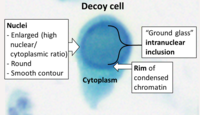
Photo from wikipedia
Introduction: The absolute BK viral load is an important diagnostic surrogate for BK polyomavirus associated nephropathy (PyVAN) after renal transplant (KTX) and serial assessment of BK viremia is recommended. However,… Click to show full abstract
Introduction: The absolute BK viral load is an important diagnostic surrogate for BK polyomavirus associated nephropathy (PyVAN) after renal transplant (KTX) and serial assessment of BK viremia is recommended. However, there is no data indicating which particular viral load change, i.e., absolute vs. relative viral load changes (copies/ml; percentage of the preceding viremia) is associated with worse renal graft outcomes. Materials and Methods: In this retrospective study of 91 biopsy proven PyVAN, we analyzed the interplay of exposure time, absolute and relative viral load kinetics, baseline risk, and treatment strategies as risk factors for graft loss after 2 years using a multivariable Poisson-model. Results: We compared two major treatment strategies: standardized immunosuppression (IS) reduction (n = 53) and leflunomide (n = 30). The median viral load at the index biopsy was 2.15E+04 copies/ml (interquartile range [IQR] 1.70E+03–1.77E+05) and median peak viremia was 3.6E+04 copies/ml (IQR 2.7E+03–3.3E+05). Treatment strategies and IS-levels were not related to graft loss. After correction for baseline viral load and estimated glomerular filtration rate (eGFR), absolute viral load decrease/unit remained an independent risk factor for graft loss [incidence rate ratios [IRR] = 0.77, (95% CI 0.61–0.96), p = 0.02]. Conclusion: This study provides evidence for the prognostic importance of absolute BK viremia kinetics as a dynamic parameter indicating short-term graft survival independently of other established risk factors.
Journal Title: Frontiers in Medicine
Year Published: 2021
Link to full text (if available)
Share on Social Media: Sign Up to like & get
recommendations!